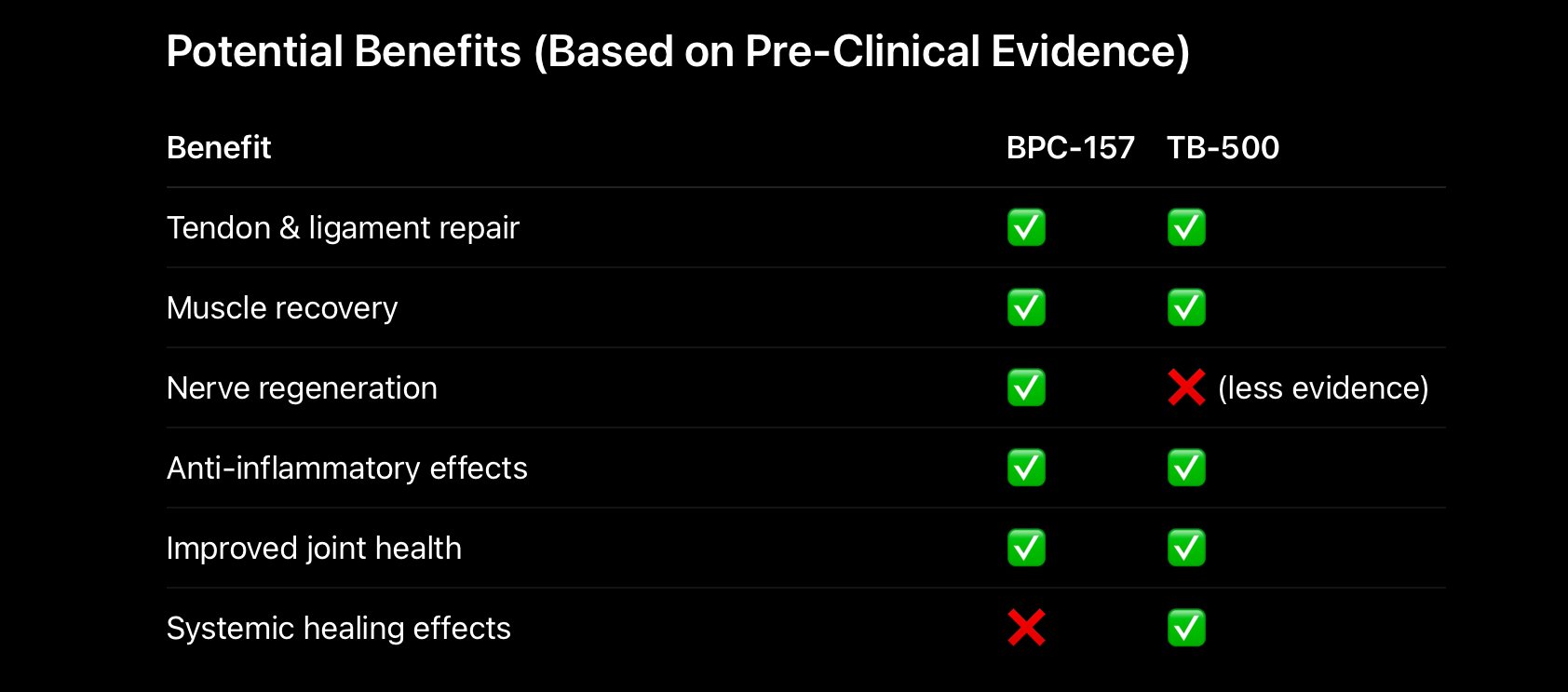BPC-157 and TB-500: The Truth About Healing Peptides, Dosage, and Risks
When it comes to injury recovery and performance enhancement, few topics stir as much interest—and controversy—as BPC-157 and TB-500. Branded by enthusiasts as “healing peptides,” these compounds are increasingly discussed in athletic, rehabilitation, and biohacking circles.
But do they really work? How are they dosed? And most importantly—are they safe and legal?
This article takes a science-based look at both peptides, cutting through the hype to explore what the research actually says, who might benefit, and where the risks lie.
What Are BPC-157 and TB-500?
BPC-157
• Full name: Body Protection Compound-157
• Origin: Derived from a protein found in gastric juice.
• Proposed benefits: Accelerated tendon, ligament, and muscle repair; reduced inflammation; potential neuroprotective effects.
• Research stage: Primarily animal studies—very limited human clinical trials.
TB-500 (Thymosin Beta-4 Fragment)
• Origin: Synthetic version of a naturally occurring peptide present in most human cells.
• Proposed benefits: Promotes cell migration, angiogenesis (new blood vessel growth), and tissue regeneration.
• Research stage: Early pre-clinical and limited clinical research, some veterinary applications.
Why They’re Often Stacked:
Athletes sometimes combine BPC-157 and TB-500, believing their mechanisms complement each other—BPC-157 for localised healing and TB-500 for systemic tissue repair.
How Do They Work?
BPC-157 Mechanisms
• Stimulates angiogenesis (formation of new blood vessels) to injured areas.
• Modulates nitric oxide pathways, improving blood flow and nutrient delivery.
• May influence gene expression related to repair processes.
TB-500 Mechanisms
• Binds to actin, a protein crucial for cell movement and regeneration.
• Supports migration of repair cells to injured tissue.
• Encourages blood vessel growth, aiding nutrient delivery.
Dosage Guidelines – What’s Actually Used
⚠ Important: Neither peptide is approved for human therapeutic use in most countries. The following reflects anecdotal reports from research forums and is not medical advice.
• BPC-157:
• Common range: 200–500 mcg daily.
• Method: Often injected subcutaneously near the injury site; some use oral capsules, though bioavailability is debated.
• Duration: 2–4 weeks for acute injuries; longer for chronic issues.
• TB-500:
• Common range: 2–5 mg weekly, split into 2 doses.
• Method: Subcutaneous or intramuscular injection.
• Duration: 4–6 weeks loading phase, then maintenance every 2–4 weeks.
Risks and Side Effects
While many users report no immediate side effects, risks exist:
• Unknown long-term safety (no large-scale human trials).
• Potential for abnormal tissue growth or scar tissue formation.
• Infection risk from non-sterile injection practices.
• Legal and purity concerns—supplements sold online may be contaminated or inaccurately dosed.
Legal Status
• United States: Not FDA-approved for human use; legal to buy for “research purposes only.”
• UK & EU: Classified as unlicensed medicines—illegal to market for human consumption.
• Sporting bodies: Banned under WADA’s Prohibited List (S2: Peptide Hormones).
Athletes competing in regulated sports should be aware: Use will trigger a doping violation.
BPC-157 vs. TB-500 – Which Is Better?
There’s no clear winner—most claims of superiority are anecdotal.
• BPC-157: Better evidence for tendon, ligament, and nerve healing.
• TB-500: More systemic effects—may aid multiple injuries at once.
• Stacking: Common in performance circles, but unproven in controlled studies.
Bottom Line
BPC-157 and TB-500 are among the most talked-about peptides for recovery, but the science is still in its infancy.
• If you’re an athlete in a tested sport: They are banned.
• If you’re considering use: Be aware of purity, legality, and lack of human safety data.
• For most people: Structured rehabilitation, strength training, and nutrition remain the gold standard for recovery—backed by decades of evidence.
Poseidon Performance Take:
We monitor peptide research closely but prioritise proven, evidence-based recovery strategies for our clients. While these compounds are intriguing, our approach always starts with strength, movement, and rehabilitation fundamentals.

